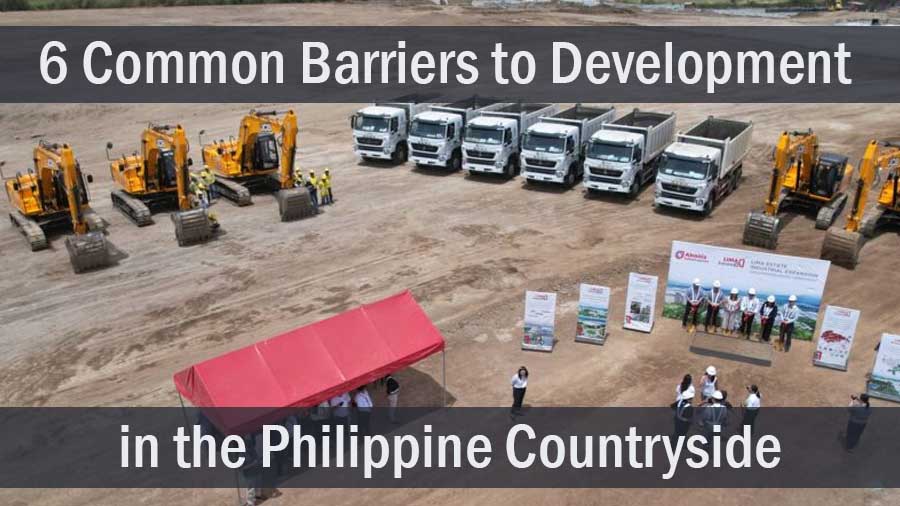6 Common Barriers to Development in the Philippine Countryside
The Philippines is not the only country in the world that faces developmental rifts between its cities and its countryside. However, it faces especially serious challenges in developing areas outside its major cities due to its geography and its diverse range of communities. Even as the country’s urban centers have experienced significant growth and development in recent decades, many rural areas continue to struggle with various barriers that hinder their progress. These barriers are numerous and varied, and they play a significant role in hindering truly equitable economic development.
In this article, we will take a closer look at some of the issues that keep rural Filipinos from benefiting from the country’s economic growth.
1) A Lack of Critical Infrastructure
One of the most significant barriers to development in the Philippine countryside is the lack of important infrastructure. Generally speaking, building and maintaining new infrastructure tends to cost less in already built-up cities because the other existing infrastructure tends to lower the associated expenses. In contrast, building in rural areas can be expensive because there are fewer existing infrastructure assets to offset the cost and comparatively fewer potential users to justify the expense. As a result, market forces and developmental policies in the Philippines often heavily favor urban areas for development.
This puts rural areas in a bind as a continuing lack of vital infrastructure can put them perpetually behind the cities, effectively limiting economic growth and quality of life opportunities for inhabitants. The continuing absence of well-maintained roads, bridges, and public transportation systems, including airports and seaports, has made it difficult for less-developed Philippine provinces to access markets, healthcare, and other essential services. This lack of vital infrastructure also affects the ability of businesses to operate and expand, thereby limiting economic growth.
Fortunately, there has been a recent increased focus on developing vital countryside infrastructure. In particular, seaport and airport development has been ramped up throughout the country, and airport operations and maintenance services have been improving with the help of private sector partners like Aboitiz InfraCapital. This has been helping much of the countryside better overcome the limitations imposed by the Philippines’ archipelagic geography.
2) Limited Access to Technology
Throughout history, technology has always played a vital role in driving development and growth. In the present day, access to digital technology and, thus, global markets can determine the real limits of economic growth in any given area.
However, rural areas in the Philippines often have limited access to modern digital technology largely due to the aforementioned lack of infrastructure. This lack of access to technology is a significant barrier to education, communication, and productivity, and effectively limits the kind of economic development that rural areas can support. This collective lack of development and technology, in turn, also prevents rural Filipinos from enjoying a better quality of life.
3) Limited Access to Capital and Financial Services
Many rural communities in the Philippines lack access to capital, making it challenging for small businesses and entrepreneurs to establish and grow their enterprises.
Limited access to credit, capital, and important financial services restricts local investment and hinders the growth of provincial economies, reducing the capacity of rural Filipinos to adapt to economic and environmental changes. These challenges are further exacerbated by the lack of infrastructure and modern digital communications technologies.
Fortunately, the wider availability of digital technologies in recent years has given rural Filipinos better access to financial services. In particular, the emergence of localized fintech solutions has provided millions of underserved Filipinos with an array of financial services and better access to capital through their mobile phones.
4) Inadequate Education and Training
Education plays a critical role in the development of all communities. Unfortunately, due to a lack of infrastructure, technology, and capital, some rural areas in the Philippines have limited access to education and training, which can limit the development and capacity of the local workforce. This limited access to important upskilling opportunities not only hinders the rural population’s ability to compete in the job market but also results in a widening of existing inequality, as upward mobility is prevented.
5) Environmental Degradation
Environmental degradation, particularly ground and water pollution, now threatens the development of rural areas. These problems not only hinder agricultural productivity and livelihoods, but they also negatively affect the food security and political stability of the entire country. Additionally, environmental degradation also directly threatens the health and well-being of rural communities, which raises the cost of development and limits the productivity of local populations by forcing them to spend more resources managing health issues.
6) Limited Healthcare Access
Unfortunately, when people in the countryside do develop health issues, they tend to have fewer options and poorer health outcomes than their urban counterparts. The distance to healthcare facilities, the added cost of healthcare services due to the lack of infrastructure and investment, and the lack of healthcare providers are significant barriers to healthcare access in rural areas. Poor healthcare often results in less productive communities, further limiting the potential of rural areas to generate economic value. Additionally, it can also contribute to the spread of communicable diseases, reducing the quality of life.
Working Together Toward a More Productive Countryside
The Philippines countryside faces many obstacles to equitable development, and a lot of these can be linked to a lack of infrastructure stemming from historical underinvestment. Collectively, these barriers pose significant challenges to both the well-being and development of rural communities while further contributing to the Philippines’ urban-rural divide.
While addressing these issues will be a serious challenge, the country is already making headway by developing the infrastructure that various countryside communities need to thrive. With the participation of all the country’s economic stakeholders, there is little reason to believe the Philippines cannot achieve more equitable development and a better life for its rural inhabitants in the coming years.


